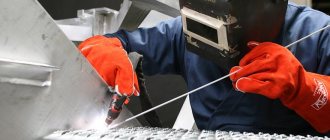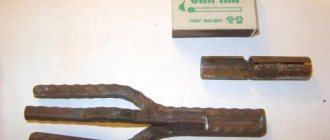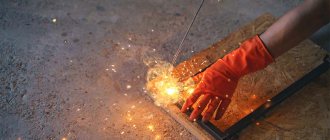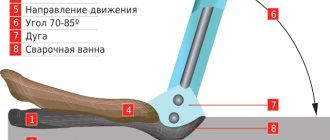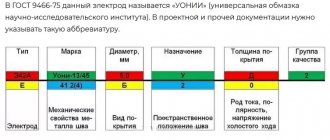Welding electrodes are special metal rods used for welding. They come in several types, depending on the type of welding and metals. Electrodes must be used strictly for their intended purpose. They are divided into metal (consumable and non-consumable - tungsten, thoriated, etc.) and non-metallic (non-consumable - coal or graphite). Consumable electrodes can be coated (cast iron, steel, aluminum, bronze, copper) or uncoated. The holder for this equipment is usually selected separately; it is desirable to have the ability to fix electrodes of different diameters.
Which electrodes are better
First of all, it is necessary to list the criteria according to which the selection of electrical conductors occurs:
- Beginner welders are recommended to use rutile-coated consumables; for experienced welders, rod coating does not play an important role;
- electrodes can be consumable and non-consumable;
- it is necessary to determine the design, product or equipment of what type to be welded;
- the choice also depends on the grade of steel being processed (see purpose);
- thickness of products;
- The type of work also has a significant impact: complex and massive structures are welded with large-diameter electrodes, welding of profile elements is carried out with materials up to 2 mm in diameter;
- type of welding current and polarity of its connection;
- and not the least role is played by the quality of welding electrodes.
Do not use materials with chipped coating!
For newbies
Most often, the question about which ones are better and which ones are worse is asked by beginners, so let's start with what are good electrodes for beginners. As stated earlier, the preferred electrode option for beginners is rutile-coated rods. This is due to the fact that this type of conductor is characterized by ease of use.
The most popular brands with rutile coating:
- ANO-4.
- MP-3.
- OK 46.00 (in the picture).
- UTP 65D.
For household welding
Household welding is characterized by a low level of complexity, as well as the absence of special requirements for the reliability and quality of the weld. Ease of operation is expected. Therefore, we will separately consider good electrodes for household welding.
Household welding includes work on the manufacture of small structures (for example, welding of fencing systems (fences), greenhouse frames, etc.), performing small work in a garage or at the construction site of a private house.
ANO electrodes (in the picture on the right) are most often chosen for welding at home. This brand is suitable for working with almost all types of welding inverters. Therefore, it has become widespread among beginners and home craftsmen.
Conductors of the MP-3 brand are distinguished by their versatility and unpretentiousness. These consumables allow you to weld even wet, rusty and poorly cleaned surfaces.
UONI - electrodes for a durable seam, have a more capricious “character”. To weld this brand, you must have certain skills, but SSSI can be used for welding surfaces of any complexity. [ads-pc-2][ads-mob-2]
For welding stainless steel
Welding electrode EA-400/10T.
Now, which electrodes are better for welding stainless steel. Many home craftsmen are often interested in the question: is it possible to weld stainless steel with conventional electrodes? It is possible to connect stainless steel with this type of consumables, but it is not entirely professional and the welding seams may soon become covered with rust.
List of the most popular brands of electrodes for welding stainless steel:
- NZh-13.
- OZL-8.
- TsL-11.
- TsT-15.
- EA-400/10T.
- OK 63.30.
Video
Watch a short video that demonstrates welding stainless steel with a “black” electrode, but as you can see from the ratings of the video and comments on the video, such welding causes mixed opinions among professionals and amateurs.
The full list can be found in the “Stainless steel electrodes” section.
For welding cast iron
Electrodes OZZHN-1
What good electrodes for welding cast iron would you recommend? Cast iron is one of the most popular materials used in a variety of applications and applications. There are several types of cast iron: malleable, gray, high-strength, etc.
As a rule, almost all of the electrodes listed below are suitable for cast iron, but not any type (the electrode must correspond to the grade of metal, but this is a topic for another discussion):
- MNC-2.
- OZZHN-1.
- OZCH-2.
- TsCh-4.
- OK 92.18.
The entire list of electrodes intended for welding cast iron is presented in the section “Electrodes for welding and surfacing of cast iron.”
For pipes
When choosing consumables for welding pipes, the main criterion is the thickness of the product. The thicker-walled the pipe has to be welded, the larger the diameter of the electrode should be.
There are four types of joints that are used when welding pipes:
- end-to-end;
- overlap;
- vtavr;
- in the corner.
The type of connection also affects the choice of electrode brand.
In addition, it should be remembered that the classification of pipes is quite extensive, so choosing the best electrodes for pipes is an incorrectly posed question. To work with critical pipelines, electrodes designed for complex welding processes should be used. Consumables for welding household pipes (for example, water pipes) are not subject to increased requirements for strength and reliability.
Popular brands of welding materials for welding pipes:
- ZIO-20.
- TML-1U.
- UONI-13/55.
- TsU-5.
A complete list is presented in the section “Electrodes for pipe welding”.
It should be noted that LB-52U electrodes are the most popular among professional welders. This brand is excellent for welding critical tanks; gas pipelines, inside of which high pressure is maintained.
Amateurs and novice welders for domestic purposes are recommended to purchase grades with rutile coating: ANO-4, MR-3S, OK 46.00 and others. [ads-pc-3][ads-mob-3]
For inverter
Again, beginners ask the question: “Which welding electrodes are best for an inverter?” On the modern market of welding materials there is a great variety of electrodes for inverters.
Most (and almost all) brands are suitable for equipment of this type, since such units produce direct current. And if the electrode cooks “alternately,” then it will also cook “constantly.”
If a welder has a question about the types of conductor suitable for an inverter, most likely he is a novice specialist. Accordingly, it is recommended to use consumables with rutile coating.
Kobelco LB-52U
Another type of welding electrode, which is manufactured in Japan. It is worth noting that these products are used in cases where it is not possible to work on both sides of the surface, for example, when welding a pipeline.
The substance is very expensive, but the quality speaks for itself. The reliability of these electrodes is justified by the high price, as well as numerous works by experienced specialists.
For maximum reliability, it is recommended to work under direct current, however, using alternating current is also suitable, but the quality will then be slightly lower.
We recommend this type if you want to get a perfectly even seam when used with low-carbon types of steel, as well as for the ability to work in any direction. In some cases, when the material lies in a damp place, calcination up to 300 degrees may be required.
What kind of coverage is needed?
There are four main types of coating, each of which has its own distinctive properties.
1. Acid coating is mainly composed of iron, manganese, silicon and other chemical elements. Electrodes with this type of coating are marked with the letter “A”. Advantages of acid-coated consumables: high resistance to the appearance of air channels in the welded joint; the ability to process rusty products and parts with scale. The main disadvantage is the risk of hot cracks appearing in the weld metal.
2. Electrical conductors with cellulose coating are designated by the letter “C”. A special feature is the high content of organic substances (mass fraction can reach 50%): cellulose, organic resins, ferropalms, etc. When burned in an arc, this type of coating releases a large amount of protective gases and a small amount of slag. This guarantees the convenience of welding work in a vertical position. Disadvantages : high hydrogen content when working with steel can negatively affect the characteristics of the deposited metal; significant amount of splashes.
3. Rutile electrodes are marked with the letter “P”. The basis of the coating is rutile, as well as some silicon and oxygen content. This type is characterized by quiet melting, a small amount of spatter, easy slag separation, and the seam has a fine pattern. An important feature is the ease of re-ignition of the arc. Welding work should be carried out in conditions of normal humidity and after calcination of the materials, otherwise the quality of the connection deteriorates and signs of oxidation appear.
4. The main coating of the electrodes is designated by the letter “B” and consists of magnesium and calcium carbonates. Conductors with this type of coating are designed to operate on direct current, as well as for connecting critical structures and pipelines. The deposited metal has an increased level of ductility and is not prone to oxidation. The main advantage is that the low saturation of this type of coating with hydrogen eliminates the deterioration of the characteristics of steel and other metals. The main disadvantage is the formation of a large amount of slag.
AURORA
The Chinese company Aurora, focused on the European and Russian markets, produces inverters using MOSFET and IGBT technology. The company's catalog includes 26 devices of the ARC, Maxima, Minion, PRO Inter, Stickmate series. All products are certified according to ES, GB standards and EAEU legislation (TR TS 010/2011 “On the safety of machinery and equipment”, TR TS 004/2011 “On the safety of low-voltage equipment”, TR TS 020/2011 “Electromagnetic compatibility of technical equipment”). The devices come with a 2-year warranty, and post-warranty support is also provided. The price of inverters, depending on power and configuration, varies from 4,000 to 112,000 rubles.
One of the most popular models is AURORA INTER 160 (10030). This welding machine can be used both for household and professional use. Operates from a 220 V network. Power is 4.6 kW, welding current is up to 160 A. The thickness of the working electrode is 1.6–4 mm. Model dimensions 290x130x200 mm, weight 5.5 kg. Distinctive characteristics include reduced spatter, easy ignition and hot start. The delivery set includes cables with a grounding clamp and an electrode holder. Price: 10,400 rubles.
Popular and best domestic electrodes for welding
ATTENTION! The following information is based on publicly available data at the time of this writing. For greater objectivity, we will make our own rating of welding electrodes, which is given below. We invite you to add your voice.
As a result of marketing research of the welding materials market, the most popular brands in recent years are:
- Resanta.
- SpetsElektrod (Moscow).
- “LEZ”.
The expert rating is as follows:
- KOMZ.
- ESAB-Tyumen.
- “Penzaelectrode”.
- “LEZ”.
- "SEZ".
[ads-pc-4][ads-mob-4]
The best welding electrodes with rutile coating RESANTA MP-3
- material – metal alloy;
- purpose – steel with a mass fraction of carbon up to 0.25%;
- cross section – 3 mm;
- product size – 35 cm;
- input current strength – 80–110 A;
- tensile strength – 450 MPa;
- material elongation – 18%;
- deposition level – 8 g/Ah;
- impact strength – 8 kgf*m/cm2.
The rating, which included the best electrodes for inverter welding, was topped by the RESANTA MP-3 model. It manually welds steels with a carbon mass fraction of up to 0.25%. The work is carried out either with direct or alternating current. Direct and reverse connections are allowed. This model is coated with rutile, a mineral composed of titanium oxide.
When welding ferrous metals with a low degree of alloying, rutile electrodes make a seam in which microcracks practically do not form, reducing the strength of the joint. These universal products are made from special Sv-08A wire, onto which a rutile sheath is applied under high pressure. The current value at the welding site is 80–110 A. The fluidity value is 430 MPa. For 1 kg of material, 1.7 kg is consumed.
The RESANTA MP-3 model is designed for manual welding of steels with a carbon mass fraction of up to 0.25%. Direct or alternating current is supplied to the welding point. The work is performed in any orientation in space.
Users like the small amount of sludge generated when using this model, the ease of ignition, the ability to work with direct and alternating current, the price is 225 rubles. Among the disadvantages are the need for careful handling so as not to damage the rutile coating, and the lack of packaging that protects from moisture.
Pros:
- performing work in any position;
- welding using direct or alternating current;
- ignites easily when moistened;
- high-quality seam;
- price 220 rubles.
Ratings
The best (popular) brands of electrodes
Materials for cast iron and stainless steel are not included due to their specificity.
The best (popular) electrode manufacturers
If you see that the ratings are missing a well-deserved brand or manufacturer, write in the comments, they will be added to the survey.
We also recommend that you read the material “How to choose electrodes for welding”, it gives advice based on what exactly you are going to weld.
Recommendations when choosing
There is no significant difference in the choice of electrodes for inverter and transformer type welding
First of all, to choose the best electrode for welding, you should pay attention to the deposition rate, packaging (be sure to make sure it is original), storage, consumption, and also check the quality certificate and manufacturer’s license
The deposition coefficient is determined by the ratio of the content of useful (pure) metal in the rod. Popular brands cannot always boast of high performance. If the transportation, period and place of storage of the rods are violated, the quality of the material deteriorates.
Operating modes
So, how to choose the right mode to ensure high-quality and durable work? First, pay attention to the spatial position. When welding, the metal flows down one way or another, so in a vertical position it is better to set the minimum current to control the rate of metal melting. Using the same logic, select the current mode for other positions. Below you can see a table in which we have collected the main operating modes.
The best budget inverter welding machine Wert SWI 190 (TIG, MMA)
- two types of welding;
- hotstart;
- protection against electrode sticking.
The universal tool leads the ranking of the best budget inverter-type models. The unit operates using TIG and MMA technology. The power is low - 3.5 kW, but the tool is inexpensive - less than 3,000 rubles. The highest current strength is 190 A.
Due to its compactness and lightness (weight less than 2.5 kg), it is appreciated by installers performing high-altitude work. Useful options include hot start, protection against electrode sticking, and the ability to adjust arc force.
The small-sized device is suitable for welding by weight, at height.


